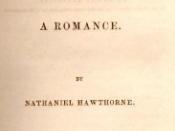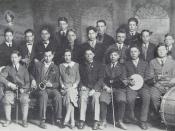Although many passages in The Scarlet Letter are effective or rich, the passage above strongly exemplifies the richness of the novel because it works on several levels simultaneously. This passage concludes the piece by adding a closure to a long awaited end; it also illustrates the figurative power that Pearl had in the story; and lastly, this passage contradicts the early beliefs of the townspeople by allegorizing the passion and the sympathy that lay masked inside Pearl. All in all, this passage is clearly the passion and soul of The Scarlet Letter.
This passage brings closure to the novel and to the Hester, Pearl, and Arthur saga. Throughout the novel, Pearl was forced to hide their terrible secret of iniquity. Hester compelled herself to keep this painful secret in order to protect the honor of Arthur Dimmesdale. In the first scaffold scene (chapter III), in response to the taunting of Mr. Wilson and others referring to the hidden man involved in her adultery, Hester responds: "Never! It is too deeply branded.
Ye cannot take it off. And would that I might endure his agony, as well as mine. "æI will not speak" (p. 47) Arthur Dimmesdale, the minister, suffered through his own self-guilt. In chapter eleven, Dimmesdale's guilt is elevated. "It is inconceivable, the agony with which this public veneration tortured him! It was his genuine impulse to adore the truth, and to reckon all things shadow-like, and utterly devoid of weight or value, that had not its divine essence as life within their life." (p.98) Although he remained in secret, he continued to punish himself. Dimmesdale ascended the scaffold times before, but not in the sight of the public. In the end, Dimmesdale climbed the scaffold because his heart and his morale would no longer allow him to remain in secret with his sanity. This passage is significant because when reading the novel in its entirety, one can come to this passage and witness how elegantly all the elements of this novel are brought together to conclude the story.
This passage also clearly defines Pearl's place and significance in the novel. It also demonstrates how powerful and influential she and her kiss were. The kiss caused "a spell to be broken"(p. 175) In The Scarlet Letter, Pearl was given the job of a metaphorical messenger of anguish, however, not of her free will. It was placed on her by the cruelty of the townspeople. Throughout the novel, she seemed to have an prominent effect on the mood and actions of the characters in the novel. She was divergent because she was the product of the adultery and sin of Hester and Arthur Dimmesdale. The kiss given to Arthur Dimmesdale after his death was given to him to seal a debt that he owed to her. Earlier in the novel, Pearl requested that he stand upon the scaffold with her and her mother to face the public. Pearl states: "Wilt thou stand here with my mother and me, to-morrow noontide?"( p.105) Three times she asked this of her father and she was thrice denied. In response to Pearl's inquiry, Dimmesdale states: "Not then, Pearl, but another time. At the great judgement day!" (p.105) The only way Dimmesdale could receive the kiss that he asked for her was if he would mounted the scaffold in the noontide with Hester and Pearl and in chapter 23, this is what he does. After seven years of Hester's ignominy, Dimmesdale finally came out, after his heart brought him through all of his suffering, upon the scaffold. This kiss broke the spell of secret and the secret of there mortal sin. This passage is especially important not only because it reveals the power that Pearl possessed, but also exhibits the promise that Pearl remembered and kept with her father, Arthur Dimmesdale.
Finally, this passage contradicts the early sentiments of the townspeople by allegorizing the passion and the sympathy that lay masked inside Pearl. Throughout the story, Pearl was given the persona of an evil demon child, an elf; she was made to be the personification of mortal sin. In chapter eight, the old minister stated: "Pearl?-Ruby, rather!-or Coral!-or Red Rose, at the very least, judging from thy hue!" (p. 75) In this tale, the color red is a hue that signifies and directly ties into the scarlet letter and all of its connotations. Pearl had not known anyone personally outside her mother's care. She had been forced to remain with her mother at all times. In chapter eight, the governor threatened to take Pearl away from her mother, but Dimmesdale argued why she should not be taken out of her mother's care. He argues: ""æIt (Pearl) was meant for a blessing; for the one blessing of her life. It was meant , doubtless, as the mother herself hath told us, for a retribution too; a torture, to be felt at many an unthought of moment; a pang, a sting, an ever-recurring agony, in the midst of a troubled joy! Hath she not expressed this thought in the garb of the poor child, so forcibly reminding us of that red symbol that sears her bosom?" (p. 78) In this story, Pearl did just that. She remained a constant reminder of her mother's sin. However, in chapter twenty-three, this changed. The saga was over and her job as "a messenger of anguish was fulfilled"(p. 175) This kiss revealed the passion and the sorrow that lay clandestine inside Pearl. This passion could only be revealed by this passage. Then and only then, could Pearl be lifted of this title as a demon child; she showed that she was human, that she had feelings and that she was able to sentimental and caring, contrary to the beliefs of all those in their society.





